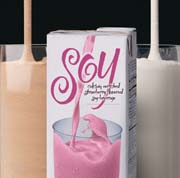Hydrocolloids provide physical stability to protein-based beverages by suspending insoluble solids, extending emulsion stability and improving mouthfeel. Carrageenan is an effective stabilizing hydrocolloid for neutral pH, soy-based beverages. Carrageenan stabilizes soy beverages by establishing a "fluid" structural network, both on its own and by interaction with protein.

What is carrageenan?
Carrageenan is a naturally occurring family of carbohydrates extracted from red seaweed. Carrageenan provides specific gelling, thickening and stabilizing properties.There are a variety of carrageenans, all of which are sulfated high-molecular-weight polysaccharides made of repeating galactose units and 3,6 anhydrogalactose joined by alternating alpha-1-3 and beta-1-4 glycosidic linkages. It is the number and position of the ester sulfate groups that influence the properties of kappa, kappa-2, iota and lambda carrageenan. Understanding how these carrageenans differ in functionality is helpful when selecting an effective stabilizer for protein-based beverages.
The higher levels of ester sulfate lower the solubility temperature and produce a lower strength gel. Gelling carrageenans, in general, are dispersed, heated to solubilize and cooled to form a double-helix gel. Kappa carrageenan forms strong rigid gels, while iota forms softer, more elastic gels. Kappa-2 forms a weaker gel than either kappa or iota. Lambda forms a viscous solution. Combinations of these carrageenan types are used to achieve stability in specific formulations and processes.
One very important property of carrageenan is its ability to complex or interact with milk proteins. At peripheral locations on the casein micelle there is a high concentration of positive charges. This positive ionic charge attracts the negatively charged sulfate groups of the carrageenan molecule to form linkages among dispersed casein micelles. This reaction, in combination with its water-gelling property, enhances the overall functionality. For this reason carrageenan will form a weak thixotropic "broken" gel structure, which will suspend cocoa in chocolate milk beverages as low as 200 ppm.
Carrageenan-protein interaction
Milk and soymilk have about the same amount of total protein, approximately 3.25%. In milk, however, 2.5% is casein and the remainder is globular whey protein. In soy beverages, the protein is entirely globular protein, meaning there is no casein component to interact with the carrageenan. This changes the stability requirements.These changes may be estimated by an evaluation of gel strength. Water gels made with carrageenan were compared to milk protein gels and soymilk protein gels, each made with 1% carrageenan. The gel strength of the milk protein gel is many times stronger than the gel strength of a soymilk protein gel. As expected, the milk protein-carrageenan interaction is stronger than a soy protein-carrageenan interaction. (See graph.)
There are also differences in the strength of the carrageenan-protein interaction for the different types of carrageenan. Kappa and kappa-2 carrageenan have little or no interaction with soy protein, but do interact with milk protein. Iota and lambda carrageenan interact more strongly with soy protein, similar to their interaction with milk protein.
The contribution of cations, in particular potassium and calcium, were also considered. When using kappa or kappa-2, cations need to be considered in the overall contribution to gel strength, although more so with soy than with milk. When iota is used, cations do not appear to contribute significantly to the overall gel strength with either milk or with soy.
Stabilizing soy beverages
How can this information be used to estimate stability in a finished soymilk beverage?Stability is defined by effective suspension of insoluble components such as added calcium and, in the case of a chocolate beverage, added cocoa. The beverage should have a consistent appearance and a free-flowing, uniform texture, meaning no phase separation and no tendency toward gelation.
One way of comparing stability is to determine index and spread. Index (ppm) is a measure of reactivity, i.e., the concentration required to generate a specific viscosity as compared to a reference. Spread is the concentration range in ppm where a stable product is produced (no settling and no gelation). The idea is to use as low a level of stabilizer as is needed to achieve the desired functionality, but still allow for a wide formula and process tolerance. By proper choice of carrageenan type this can be achieved.
Two new carrageenan ingredients have been specifically designed to stabilize UHT (ultra-high temperature) soy beverages. These carrageenan products are suitable for use in direct- and indirect UHT-processed soy beverages. They provide uniform suspension of insoluble solids and improve emulsion stability to reduce creaming. Developed by FMC BioPolymer, Princeton, N.J., the carrageenans are sold under the name SeaKem®.
Specifically, SeaKem XP 3575 carrageenan provides consistency in soymilk. It has less of a tendency to gel, good stability, low viscosity and acceptable mouthfeel at 250 to 450 ppm. SeaKem XP 3577 carrageenan provides a consistent soymilk beverage and avoids the tendency toward mottling and/or serum separation. Good stability is achieved, producing a beverage with a low viscosity and with a pleasing and creamy mouthfeel.
Another new product is Avicel-plus® XP 3578, which combines microcrystalline cellulose (MCC) with carrageenan to enhance stability under adverse storage conditions. It is designed to provide excellent stability at 1,300 to 2,500 ppm for extended shelflife stability. It provides stability against heat-shock and abuse storage and delivers an enhanced mouthfeel. All of these unique ingredient systems provide the benefits of greater stability and higher quality in a cost-effective manner.
Carrageenans that work best
A comparison was made of each carrageenan type, including variation by molecular weight, under UHT process conditions for fluid soymilk stored under refrigerated conditions. The results indicated that kappa gave the lowest index with a narrow spread. The kappa-2, iota and lambda carrageenans each demonstrated a subsequently higher index and a wider spread, which suggests that more stabilizer might be needed but a greater formula tolerance would be possible.These results indicated that by combining a strong carrageenan type, such as kappa, with a wider range, weaker gelling carrageenan such as iota, a product can be designed to provide specific desired advantages as an end use stabilizer. Relying on a single carrageen type may be too restrictive in use level. This is how FMC BioPolymer identified the new carrageenan lines.
Carrageenan may also be used in combination with MCC. When properly dispersed, particulates of insoluble MCC and a soluble hydrocolloid component set up a thixotropic structural network. That network is able to suspend insoluble solids, enhance emulsion stability and foam stability, and contribute to unique textural properties in aqueous food systems such as beverages and desserts. Temperature has little effect and functionality is provided in food systems processed under UHT, aseptic, retort and microwave conditions.
The thixotropic structural network provides the additional structure needed when the finished soy beverage may be subject to storage abuse or when packaging soymilk aseptically at higher filling temperatures. Higher filling temperatures may not allow for immediate setup of a full carrageenan-carrageenan gel. Thus, in these instances, MCC fills in the structure until the complete carrageenan gel can be established. Similarly, in regions of the world where climate-controlled and air-conditioned storage is unavailable, MCC maintains the necessary structure to insure stability, since the MCC structural network is unaffected by changes in temperature.
Both carrageenan and MCC have been used for many years to effectively stabilize high-quality chocolate and calcium-fortified beverages. Now with growing interest in the health benefits associated with soy, FMC BioPolymer can provide the stabilizer system best suited to insure refreshing, good tasting soy-based beverages.
